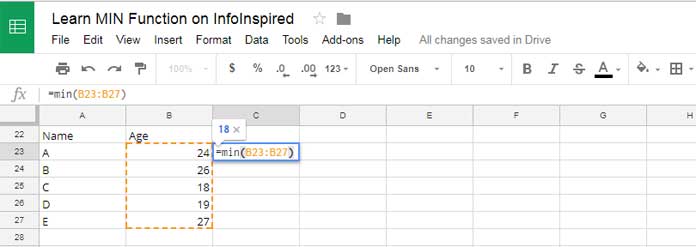There are several functions focusing on the minimum values in Google Sheets. You can find Database as well as statistical functions in the list. SMALL, MIN, MINA, DMIN are some of them. You can refer my Functions Guide to learn more. I’ll update the guide as and when the relevant tutorial is ready. Here we are going to learn how to use MIN function in Google Sheets. I’ve already featured SMALL function which is also a statistical function similar to MIN. So you can definitely expect a comparison of MIN vs SMALL at the end of this tutorial.
How to Use MIN function in Google Sheets
Purpose: The purpose of MIN function is to return minimum value in a numeric Data Set.
Syntax:
MIN(value1, [value2, …])
Basic Example to Google Sheets MIN function:

The above MIN function returns the minimum value in the selected numeric range in Column B. You can use the MIN formula as below when the values to test are in non-adjacent cells.
=MIN(B23,B24,B25,B26,B27)
Important Note:
When your selected range contain the value zero, the MIN formula would return zero as the minimum value. You can skip 0 in MIN return by using Filter as below.
Exclude Zero Values in MIN in Google Sheets
Advanced Use of MIN Function in Google Sheets
Now let’s see a more advanced use of Google Sheets MIN function.
In our above example (see the screenshot above), I’ve actually used the MIN formula to return the minimum age of a person in the selected range. The formula returns the minimum number 18. Can we return the name of the person whose age is 18? Yes, you can do it with a vertical lookup.
You can use MIN function in Vertical Lookup. With the help of an Index and Match formula combination (please note that this combination is an alternative to Vlookup and useful in reverse lookup) that combine with MIN, you can return the name of the person who’s younger in the list.
MIN Advanced Tutorial: Lookup Minimum Value in a Column and Return Corresponding Value from Another Column.
Difference Between MIN and SMALL Functions in Google Sheets.
As I’ve mentioned in the beginning of this tutorial, here is the comparison. SMALL is another function in Google Sheets to return the smallest element from a data set. But this function has one major difference with MIN.
Here again I request you to refer my first sample data and example. There I could find the youngest person in the list with MIN function. What about the second youngest person in the list. Here you can use SMALL formula, since this function can return a user defined MIN number. The formula would be;
=small(B23:B27,2)
This would return the result 19 and which is the second smallest number in the range.
In the above advanced use of MIN function, I’ve detailed how to lookup MIN value and return corresponding value from another column. The same way you can perform a vertical lookup to return a user defined occurrence of an item using SMALL with Index and Match Combination.
Reference: Vlookup to Find Nth Occurrence in Google Sheets
If you have any doubt about How to Use MIN Function in Google Sheets, do drop in comments.





















